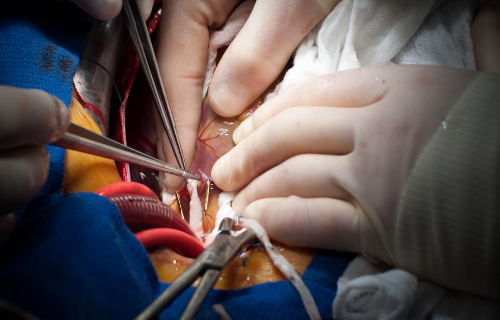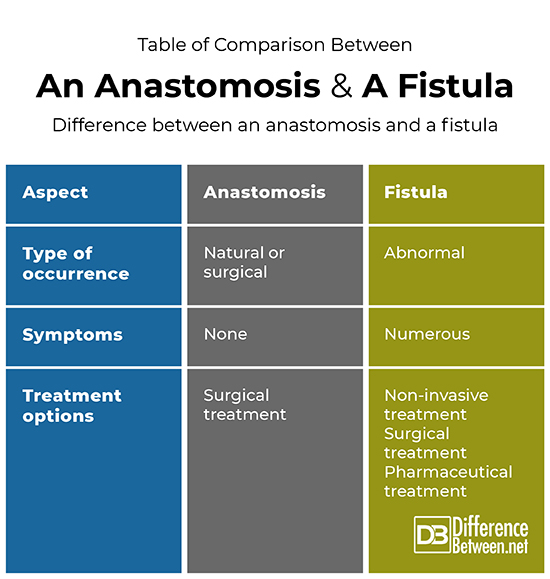Difference Between Anastomosis and Fistula

Introduction
The connection of two parts in the human body can either be normal, surgically created, or abnormal. When these connections are normal or surgically created, they are referred to as an anastomosis. When there is a connection in the body which is abnormal, it is referred to as a fistula. All of these connections are the result of various causative factors.

Definition
Anastomosis refers to the connection of two parts that usually diverge. In the medical field, anastomosis usually refers to a connection between two portions (or loops) of intestine or between blood vessels. Anastomoses are either naturally occurring in the body, or they are created by surgical intervention.
Natural Anastomoses
Anastomoses occurring naturally throughout the body refer to natural connections between structures. For example, the natural connection between arteries and veins. These natural connections assist the body in transporting nutrients, gases, and blood efficiently and effectively.
Surgical Anastomoses
Surgical anastomoses refer to connections which have artificially been created by a surgeon through a procedure. Oftentimes, these procedures are done when there is a blockage in an artery or vein, or when a portion of the intestine becomes obstructed. Surgical anastomoses can also be performed when there is a growth or tumour found in the intestine, this is done following the removal (or resection) of the affected intestine. After removal of a portion, reattachment can be done by sewing or stapling the newly anastomosed area.
A fistula is commonly defined as the abnormal connection or pathway between organs or arteries and veins, which do not usually connect. These connections can occur in any region throughout the body, for example:
- Between the intestine and the skin (enterocultaneous/colocutaneous fistula)
- Between the vagina and the rectum (rectovaginal or anovaginal fistula)
- Between the anal canal and the area located at the anal opening (anorectal fistula)
- Between the vagina and the colon (colovaginal fistula)
- Between the bladder and the uterus (vesicouterine fistula)
- Between the bladder and the vagina (vesicovaginal fistula)
- Between the urethra and the vagina (urethrovaginal fistula)
- Between two parts of intestine (enteroenteral fistula)
Fistulas can be caused after childbirth and when a woman goes into labour which becomes obstructed without relief. Other diseases and conditions can also cause this complication. Diseases such as Chron’s disease, diverticulitis in the intestine, as well treatments such as radiation therapies.
Symptoms
An anastomosis is not abnormal or unplanned, therefore there are no symptoms applicable.
In the case of a fistula, there are symptoms present and these include:
- Urine leaking out if the vagina
- Irritated genital organs (externally)
- Frequent bladder infections or urinary tract infections
- Leaking gas and/or faecal matter into the vagina
- Nausea
- Vomiting
- Diarrhoea
- Increased pain in the abdominal region
Risks and complications
After a surgical anastomosis, there is an increased risk of blood clots in the localized area or small blood clots which travel to the heart and lungs through the blood vessels, infections, scarring, bleeding, wound rupturing, anastomotic leak (also possibly leading to infection), and changed bowel movements
In the occurrence of a fistula, there is a risk for loss of bowel control, slow wound healing, returning fistulas, narrowed anal canal causing restricted bowel movements, infections, and bleeding and clotting.
Treatment options
For anastomoses procedures, surgical treatment options involve three types of anastomoses:
- End-to-end: where two open ends are connected together
- Side-to-side: where two sides of each end are connected together, and the ends are closed via stapling or stitching (this treatment option carries less risk)
- End-to-side: where one side and one end of two ends are connected together.
The choice of treatment option is dependent on the type of condition and the preferred technique of a specialist surgeon.
In the treatment of fistulas there is the option of non-invasive options as follows:
- Fibrin glue: a specialized medical glue made to seal fistulas
- Plug: a filler made of collagen in a matrix form
- Catheter: used to drain fistulas, usually small ones to manage associated infection
There are also surgical treatment options as follows:
- Transabdominal surgery: access to the fistula for repair through the abdominal wall
- Laparoscopic surgery: minimally invasive surgery using cameras and tools to access the fistula through the abdominal wall
Pharmaceutical treatment is also administered, such as antibiotics to treat infections as a complication from a fistula.
Table of comparison between an anastomosis and a fistula

Summary
Anastomosis and fistula are two terms used to describe the connection of two areas. In the case of anastomoses, this connection is either natural or surgically created. In the case of a fistula, the connection is abnormal and usually indicative of a mild to serious medical condition. Both anastomoses and fistulas can be address surgically, although fistulas can be addressed non-invasively and through medications to treat associated complications.
FAQ
Is a fistula an anastomosis?
A fistula is an abnormal connection between two parts in the body, where an anastomosis is a normal connection or a surgically created connection. Therefore, a fistula is not an anastomosis. However, in the case of dialysis treatment an arteriovenous fistula is created through anastomosis of an artery and a vein, this abnormal connection is surgically created and is therefore a type of anastomosis.
What is anastomosis in dialysis?
Dialysis is a treatment method that provides an alternative and external filtering of the blood in the case of kidney failure or compromised kidney function. An anastomosis in dialysis refers to a fistula created by a surgeon, usually in the upper limb, where an artery and a superficial vein are connected and marks the access point for haemodialysis treatment.
What are the three types of anastomoses?
The three types of anastomoses are as follows:
- End-to-end: where two open ends are connected together
- Side-to-side: where two sides of each end are connected together, and the ends are closed via stapling or stitching (this treatment option carries less risk)
- End-to-side: where one side and one end of two ends are connected together.
Where is the anastomosis located?
Anastomosis is usually located between the veins and arteries, or in the intestine.
- Difference Between a Cochlear Implant and Normal Hearing - October 4, 2022
- Difference Between Obstructive and Restrictive Spirometry - September 11, 2022
- The Difference Between White Box and Black Box Testing - September 11, 2022
Search DifferenceBetween.net :
Leave a Response
References :
[0]Lin, Peter., Bush, Ruth., Nguyen, Liz., Guerrero, Marlon., Chen, Changyi and Lumsden, Alan. Anastomotic strategies to improve hemodialysis access patency—a review. Vascular Endovascular Surgery. 2005, vol. 39, no.2, pp: 135-142.
[1]National Association For Continence. What is a fistula? https://www.nafc.org/fistula
[2]Radhakrishnan, Rohini. What Are the Three Types of Anastomosis. MedicineNet. 2020. https://www.medicinenet.com/what_are_the_three_types_of_anastomosis/article.htm#what_are_the_complications_of_intestinal_anastomosis
